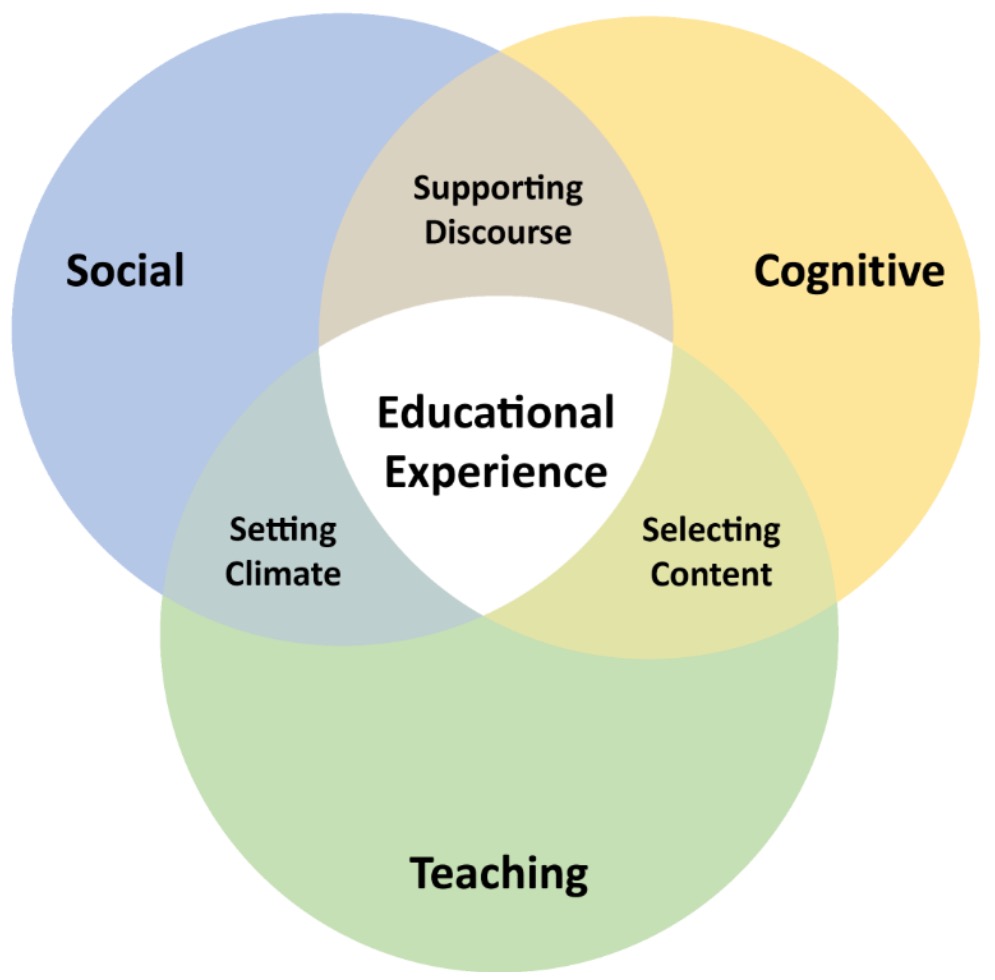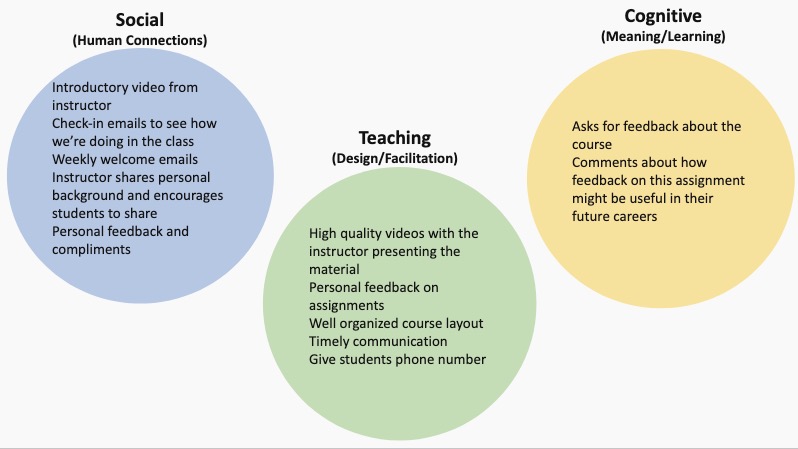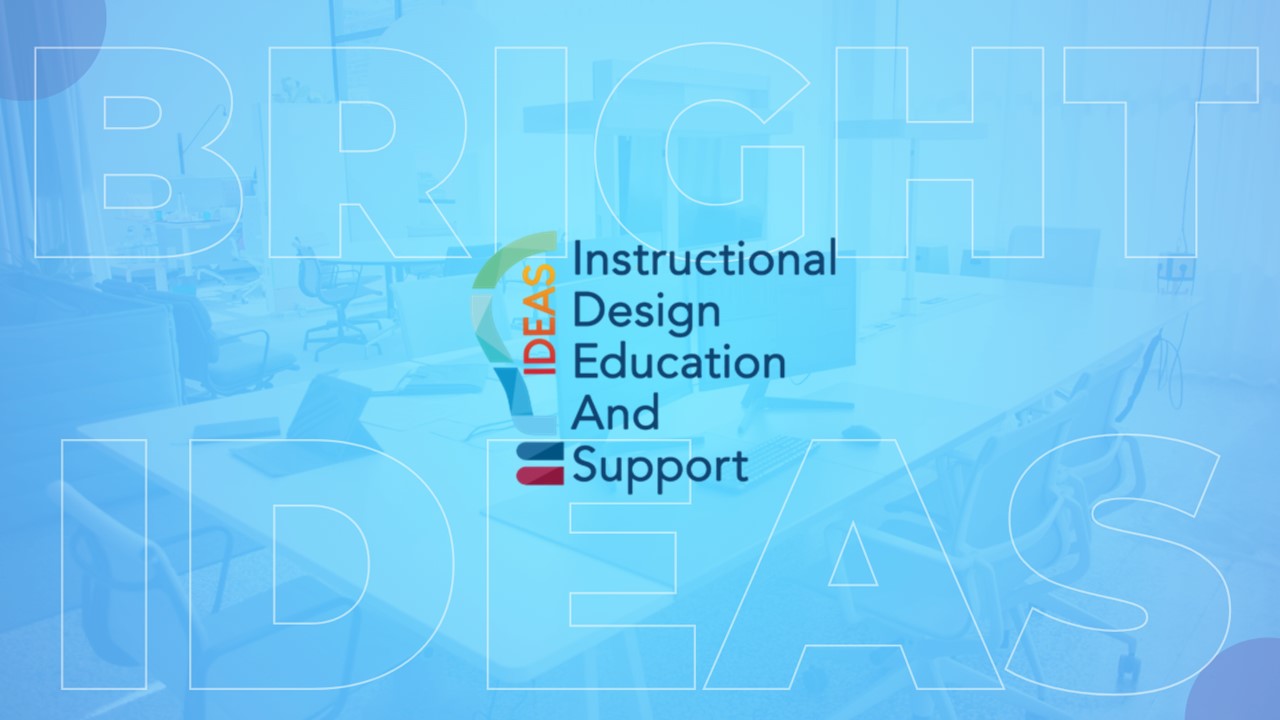Establishing Presence to Enhance the Educational Experience
Three key elements work together to impact a student’s educational experience: Social Presence, Teaching Presence, and Cognitive Presence. Research has consistently demonstrated the intersection of these three presences creates a strong and positive learning experience for students in the online instruction. When students have a sense of community, they understand the purpose of learning, contribute, connect, and feel more of a sense of ownership of their learning. The Community of Inquiry Model
What is Presence?
For the purposes of the webinar, we defined presence as the actions an instructor takes to reduce the psychological distance that tends to happen in asynchronous online learning. These actions can include such things as:
- Providing personalized, timely assignment feedback
- Active instructor engagement in online discussion boards
- Acknowledging student contributions and expertise
- Creating a comprehensive syllabus that communicates clear expectations
- Providing detailed grading rubrics
- Creating opportunities to connect ideas to prior learning and other course concepts
- Providing knowledge from diverse sources
Why is Establishing Presence Important?
- It fosters a productive learning environment and student success
- It facilitates cooperation and commitment among students necessary for achieving student goals
- It encourages exploration of concepts in depth, enhances the learning experience, increases confidence, participation and satisfaction, resulting in a greater sense of achievement
- Students experience a higher level of satisfaction with the instructor’s attitude
- Students are more motivated, focused, and less stressed
- Students Report higher course satisfaction
Community of Inquiry
The Community of Inquiry (CoI) model was developed from a study (2001) consisting of three key elements: Social Presence, Teaching Presence, and Cognitive Presence. Research has consistently demonstrated that intersection of three presences creates a strong positive learning experience for students in the online medium of instruction. When the student has a sense of community, they understand the purpose of learning, can contribute, can connect with other students, and can feel a sense of owning their learning.
Social Presence
Social presence is the ability to project one’s self socially and emotionally, thereby being perceived as “a real person” in mediated communication. Social presence facilitates critical thinking, allows learners to express themselves freely, build connections and function as a cohesive group, resulting in meaningful and engaging learning experiences.
Social Presence consists of:
- Communication between the instructor and all members of the class
- Interaction with the instructor and all members of the class
- Identification as a learning community throughout the term
- Moves from introduction to community to camaraderie
- Note: Social Presence is the main element needed before Cognitive and Teaching Presence can occur
Examples of Social Presence:
- Asking the entire class to create welcome videos
- Providing personalized, timely assignment feedback, such as media commenting
- Active instructor engagement in online discussion boards; establishing presence
- Encouraging collaboration and exchange of ideas
- Acknowledging student contributions and expertise
- Establishing group cohesion
- Engaging in supportive contact and interactions
Teaching Presence
Teaching presence is the design, facilitation, and direction of the class to obtain optimal learning outcomes. Teaching presence improves social and cognitive presence which in turn can lead to better educational outcomes.
Teaching Presence consists of:
- Instructional design, especially providing different methods of presenting content
- Organization of the course
- Facilitation of the discussion
- Moving the discussion through the four cognitive phases
- Direct instruction and assisting students with questions and understanding
- Note: Teaching Presence is a significant factor in student satisfaction and perceived learning
Examples of Teaching Presence:
- Creating a comprehensive syllabus that communicates clear expectations
- Following best practices in module structure/organization
- Ensuring that your course has an intuitive navigation
- Providing detailed grading rubrics
- Posting MyCourses announcements for weekly introductions and/or wrap-ups
- Engaging in effective and meaningful direct instruction
- Being actively involved in discussions to facilitate dialogue
- Providing timely, specific feedback on student performance
Cognitive Presence
Cognitive presence is supported by a strong foundation of teaching and social presence. It focuses on learners’ ability to construct meaning through continuous dialog and reflection.
Cognitive Presence consists of:
- Motivating students to cognitively engage with course content
- Cognitive Presence is a four-phase process
- Triggering event such as an issue or problem
- Exploration through reflection and discussion
- Meaning construction as students discuss ideas
- Application of knowledge both in the course and outside the classroom
Examples of Cognitive Presence:
- Discussing and introducing effective triggering events that create a sense of puzzlement
- Promoting information exchange
- Creating opportunities to connect ideas to prior learning and other course concepts
- Providing knowledge from diverse sources
- Creating opportunities to foster meaningful application of new knowledge
Social Presence, Teaching Presence, and Cognitive Presence form the student’s perception of instructor presence, and shapes the overal educational experience.

Titan Voices
During the webinar,faculty were asked to think about a time when, as a student, an instructor of theirs really established presence in an asynchronous online course. What types of things did the instructor do to make students feel important/valuable/connected? Faculty shared their experiences on this Google Doc: What’s been your experience with presence Google Doc. As you can see, faculty contributed a wide range of instructor actions that help to establish presence.
After learning about the Community of Inquiry and the three presnces, faculty were then asked to categorize the items they had listed on the document. In the image below you can see how the items on the document got categorized.

The webinar included a “Customer Service” approach to presence, presented by Faculty member Krishna Sadasivam.
A few students responded to the same question that was posed to faculty: Think about a time when an instructor of yours really established presence in an asynchronous online course. What types of things did they do to make you feel important/valuable/connected? Here is what some SPC students had to say:
Resources
- Webinar Presentation (PowerPoint Download)
- Webinar Recording (49:50)
- Creating Trust in Online Education
- Critical Inquiry in a Text-Based Environment: Computer Conferencing in Higher Education
- Establishing Social, Cognitive, and Teaching Presence in Online Learning—A Panacea in COVID-19 Pandemic, Post Vaccine and Post Pandemic Times
- Mechanizing People and Pedagogy: Establishing Social Presence in the Online Classroom
- Presence in Teaching
- The Community of Inquiry Model
- The Importance of Being Human: Instructors’ Personal Presence in Distance Programs
Feedback? IDEAS Event Feedback Form
Questions? IDEAS@SPCollege.edu



